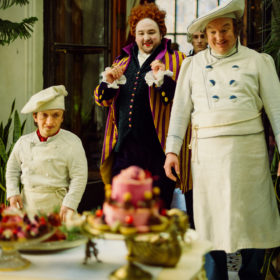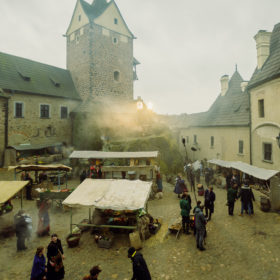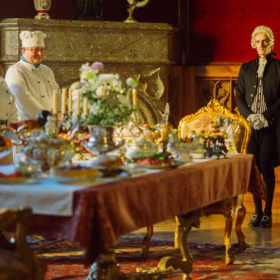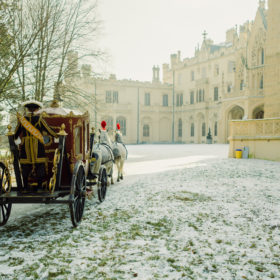A report from the set
Updated 12/04/2021
In mid-March, the German television station ZDF, in coproduction with the Czech company Mia Film, wrapped up shooting of the fairytale “The Dwarf’s Nose”. The shoot for this classic fairytale was a big one – the film crew worked at 6 Czech castles and chateaux and other locations in the country. The premiere is expected this Christmas.

Photo: MIA FILM © Jan Hromadko
“The Dwarf’s Nose” is the fifth co-production between the Czech company Mia Film and the German production Provobois Film. This shoot took place under some challenging conditions. Because of covid restrictions, the German producer did not come to the Czech Republic at all. The shooting was attended by the German production manager otherwise, as Ladislav Jelinek of Mia Film says, “All cooperation took place remotely.”
The Czech filmmakers have proven themselves in the extraordinary situation and the producer Jens Christian Susa is planning to continue the successful partnership: “The cooperation with MIA FILM, Michal Pokorny and Zbynek Pippal was great – as all the last years of experiences we made, reliably characterised by great economic and artistic skills. Next year we will coproduce another fairy tale “The Frog Prince” in the Czech Republic with MIA FILM.”
A classic fairy tale against the backdrop of Czech chateaux
Based on an original story by Wilhelm Hauff dating back to 1826, the script tells the story of the unusual friendship between a young boy, Jakob, who magically transformed into a dwarf with a huge nose and the wizard’s daughter, Mimi, who was magically transformed into a goose. Jakob and Mimi meet in the chateau kitchen, where the dwarf uses his culinary skills to gain the duke’s favor and Mimi is to be eaten for dinner.

Photo: MIA FILM © Jan Hromadko
Three unique monuments – Lednice, Libochovice and Mikulov – were combined to create the perfect chateau for the duke. In the fairytale film, you’ll see interiors from Lednice, kitchen scenes filmed in Libochovice, and outdoor scenes with the beautiful castle gate from Mikulov. The proximity of Mikulov and Lednice to each other, which facilitated production logistics, also influenced the selection of locations.
Logistics during the pandemic
Transporting actors to the shoot was complicated from the very beginning. Ladislav Jelinek said: “Shortly after the start of the shooting, Germany added the Czech Republic to the list of high-risk countries because of the SARS-CoV-2 mutation. This move, among other restrictions, brought with it border controls and a significant reduction in travel between the two countries as well as disruptions in passenger rail transport. Fortunately, we managed adapt quickly to the new rules and to ensure transport of the German actors to the shoot and back home.”

Photo: MIA FILM © Jan Hromadko
The film features Czech actors Arnost Goldflam, Dana Moravkova, and Halka Jerabek Tresnakova alongside German actors Mick Mehnert, Christian Ahlers, Daniel Zillmann, Jonathan Tittel, and Adrian Grünewald.
Support for the Czech economy
With the exception of seven people, including the director, camera crew, and architect, the crew was made up of Czech filmmakers. They prepared locations and set decoration, produced props, trained animals, and sewed costumes.
The fairytale was filmed entirely in the Czech Republic. The shooting took 21 days. In addition to Lednice, Libochovice and Mikulov, it also took place at Kokorin and Houska Castle and in Litomerice. The evil fairy’s kitchen made its home in the Grotto at Ploskovice Chateau, the town market sprang up in Loket, and Kokorin became a witch house.

Photo: MIA FILM © Jan Hromadko
The German shoot provided significant support for the Czech economy through the use of local services. The Czech Film Fund records the estimated eligible costs in the amount of CZK 28 million, the film incentive should amount to CZK 5.6 million. The services used by the film crew include accommodation, meals, transport, costume, wig, and prop rental, location rental, construction and production of props, creation of special effects, security and much more. Filmmakers regularly used the services of a covid laboratory.
Emergency measures and staff testing
When asked what made his work easier during the shoot, Czech producer Michal Pokorny answered, “The excellent cooperation with the laboratory that tested actors and crew. What also helped was a somewhat unexpected increase in the concentration and speed in the crew’s work, which was related to the requirement to use FFP2 respirators during filming.”
Filmmakers strictly adhered to all measures, often even before being required by government resolution, to ensure a safe environment for the crew and actors. In particular, it was necessary to procure a sufficient amount of protective equipment and disinfection. The entire crew, as well as all actors and extras, were regularly tested for the SARS-CoV-2 virus.
Higher expenses – higher spending
Compliance with the emergency measures, of course, significantly increased the cost of film production. More vehicles were used for transport and larger spaces were reserved for the backlot to allow proper distancing to be maintained in the dining room or during breaks. Crew accommodation and meals during free periods was also challenging, as many hotels have closed completely.

Photo: MIA FILM © Jan Hromadko
During the shoot, there was a ban on traveling across district borders. German actors had to stay in the Czech Republic until the end of their planned shooting, because in Germany they would have to go into quarantine and not be able to return for two weeks.
A fairytale happy ending
The crew managed to complete the fairtale‘s shooting happily and the Czech company Mia Film is now working on post-production.

Photo: MIA FILM © Jan Hromadko
At the end of the fairytale, Jakob and Mimi opened a pub together called “The Dwarf’s Nose”. Pubs reopening would be a happy ending for us as well. The fairytale business will open for the viewers of the German television ZDF this Christmas.